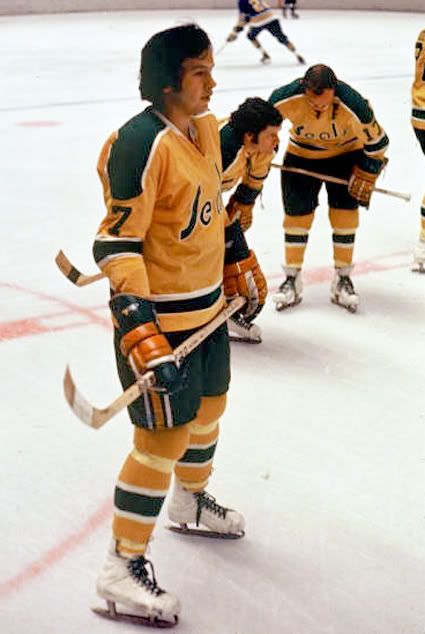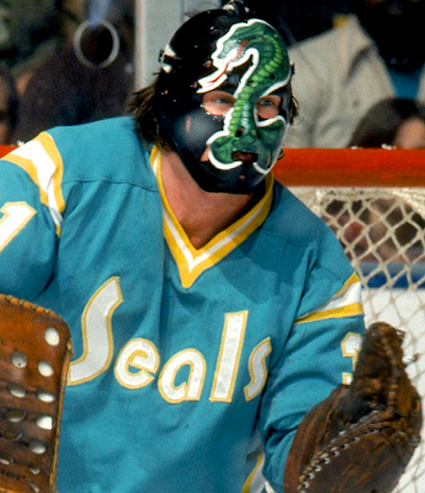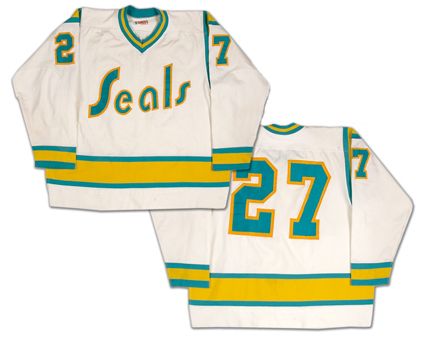Politically, Swig and the Gunds were relying on Swig's political connections with San Francisco Mayor Joseph L. Alioto to get a new hockey arena built downtown. "Alioto was very helpful, " Gund remembered. "He had hoped to put the team where the Moscone Center is now. It was very close to public transportation."Regrettably for the Seals, Swig's timing was off. Alioto was leaving office and Swig supported the wrong man in the 1975 election. When George Moscone took office, the new arena died. "The new mayor put the building on hold." Len Shapiro said. "He ran an investigation into the report and then said the survey had to be resurveyed , so basically, it went nowhere. Then there were plans to remodel the Cow Palace but that never happened either." Once those two plans fell through, the Seals were finished in the Bay Area."After the new arena in San Francisco fell through, the league gave us the go-ahead to move the team." Gund remembered. "We looked at a lot of other places. We looked at Denver and Seattle-Tacoma. We ended up picking Cleveland because hockey was very popular there."Rumors that the Seals would leave the Bay Area were almost as old as the team itself. The owners were quietly but aggressively looking over other locations. The NHL had planned expansion franchises for both Seattle and Denver, which were supposed to begin play in 1976-77. The new entires, though, were experiencing problems so moving the Seals to those cities was still a possibility.Shapiro recalled when he first got an inkling the team might be leaving. "On February 1, 1976, I realized something might be up. I was in the office with Loretta Marcus [the team's secretary] and nobody else was there. I had no idea where anybody was. I looked at Munson Campbell's schedule and it said he was booked at the Cleveland Hilton. Then I knew something must be up."George and Gordon Gund owned the Richfield Coliseum in Richfield, Ohio, where the NBA's Cleveland Cavaliers played. It was halfway between Akron and Cleveland, a location that would cause the franchise more problems in the future. In typical Seals fashion, even it's exit was not smooth. The club participated in the July 1976 entry draft as the Seals and even started selling tickets for the upcoming season in Oakland.At the 1976 entry draft, the Seals made history by becoming the first NHL team to use its frist-round draft pick on a European player by drafting Swedish defenseman Bjorn Johansson. The team didn't make it's intention to move officially known until August 26, 1976. It was announced that the team would move to Cleveland and take the name of the AHL franchise that played there for so many years, the Barons. Because of the late move, the Barons had a mere six weeks to sell tickets in their new home. Once again, the franchise started its new life behind the proverbial eight ball.
Sunday, April 4, 2010
1974-75 California Golden Seals Gilles Meloche Jersey
On this date in 1976, the California Golden Seals defeated the Los Angeles Kings 5-2 in their final game ever. The ever name changing California Seals were founded as part of the great NHL expansion of 1967-68. The San Francisco area was not considered a particularly lucrative market for hockey, but the terms of a new television agreement with CBS called for two of the six new expansion teams to be located in California, with the other club being the Kings in Los Angeles.
The Seals were supposed to have been located in San Francisco, but the planned arena was never built and instead, the team was based across the bay in Oakland. The club was originally called the "California Seals" to appeal to fans in San Francisco and address complaints from other NHL teams, who complained that Oakland was not a major league city, as it's only other professional sports team at the time was the Oakland Raiders of the American Football League. On November 6, 1967, after the franchise was just a mere dozen games old, owner Barry Van Gerbig announced that the team's name was being changed to the "Oakland Seals"!
Poor attendance led to threats by Van Gerbig to move the club and a poor record on the ice led to only seven of the original 20 players remaining on the team for it's second season. While the Seals finished with records below .500, they would qualify for the playoffs in each of the next two seasons, 1968-69 and 1969-70, the only times the club see postseason action in their nine seasons. In 1969 the Seals took the Kings to a full seven games before losing and in 1970 they were swept in four straight by the Pittsburgh Penguins.
Van Gerbig sold the team to a group called Trans National Communications in time for the 1969-70 season, but when the group filed for bankruptcy, ownership reverted to Van Gerbig, who put the club up for sale again.
The Oakland Seals were then purchased by Charlie O. Finley, owner of the Oakland Athletics baseball club, who had moved to the bay area in 1968. Never one to sit still, Finley renamed the team the "California Golden Seals" and altered the team's green and blue colors to green and gold, matching those worn by his baseball club, as well as having the team wear flashy white skates!
Unfortunately the the Golden Seals finished dead last in the NHL during their first season under Finley's ownership with just 45 points from 78 games. Even worse, their first overall pick in the 1971 NHL Entry Draft had already been traded to the Montreal Canadiens for their first round pick in 1970, used by he Golden Seals to take Chris Oddleifson, Ernie Hicke and the always needed cash. The Canadiens then used the draft choice obtained from the Golden Seals to select none other than future Hall of Famer Guy Lafleur.
The team improved by 15 points the following season, but suffered from the emergence of the World Hockey Association, as the frugal Finley refused to match the WHA's contract offers to his players resulting in five of the team's top ten scorers leaving for the rival league and the Golden Seals once again sank to the bottom of the standings with 48 points in 1972-73 and followed that up with just 36 points in 1973-74.
Matters were made worse, if that's even possible, by a divisional restructuring which somehow found the Golden Seals placed in the newly created Adams Division with the Boston Bruins, Buffalo Sabres and Toronto Maple Leafs, in an apparent effort by the league to kill off the franchise, as each of the other clubs were a minimum of 2,300 miles to the east!
Having grown tired of owning the hockey team, especially in direct comparison to his three-time world champion Athletics baseball team, Finley tried unsuccessfully to sell the Golden Seals, which was eventually eventually taken over by the NHL.
Melvin Swig then purchased the team in 1975 with plans to have the team play in a new arena in San Francisco. Those plans never came to pass following the election of a new mayor who was opposed to the plan, so after nine money-losing seasons, low attendance and few victories, minority owners George and Gordon Gund convinced Swig to relocate the team to their hometown of Cleveland, Ohio, making the club the first NHL team to relocate since 1934 and bringing to and end the Golden Seals ordeal in California, where the team had more names than playoff appearances.
Under the Gunds ownership, the Barons played in Ohio for two seasons, merged with the Minnesota North Stars, who were then sold to another group while the Gunds received an NHL expansion franchise, the San Jose Sharks, at the south end of San Francisco Bay, 40 miles from where it all started.
Today's featured jersey is a 1975-76 California Golden Seals Gilles Meloche jersey. After the departure of owner Charlie O. Finley, the Golden Seals colors were changed from his signature green and gold to the even less intimidating pastel shades of "Pacific Blue" (teal) and "California Gold" (yellow), quite probably the worst colors for an NHL team ever which were about as intimidating as Easter eggs. The change also gave the team more total color schemes than playoff appearances as well.
Not even the addition of goaltender Gary Simmons' black goalie mask with it's frightening green cobra was enough to offset the "only in California" colors of the Golden Seals final jersey set.
Aside from the unusual color scheme of the last incarnation of Golden Seals jerseys, another odd characteristic of this set was the decidedly "football jersey" style vertical stripes where the arms meet the body of the jersey, something that had never appeared on an NHL jersey before or since.
Here are some fantastic old videos of the Seals in action. Check out those rinkside seats for $5.50 and playoff tickets for $12. Sign us up!
We don't care how hard you punch, there's just no dignity in wearing those teal jerseys.
Labels:
California Golden Seals,
Meloche Gilles
Subscribe to:
Post Comments (Atom)














No comments:
Post a Comment
We welcome and encourage genuine comments and corrections from our readers. Please no spam. It will not be approved and never seen.